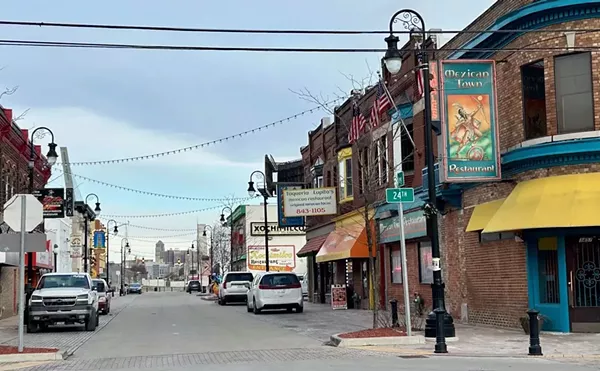
Audio By Carbonatix
[
{
"name": "GPT - Leaderboard - Inline - Content",
"component": "35519556",
"insertPoint": "5th",
"startingPoint": "3",
"requiredCountToDisplay": "3",
"maxInsertions": 100,
"adList": [
{
"adPreset": "LeaderboardInline"
}
]
}
]
If you live in Detroit's suburbs and always thought poverty was an urban problem, think again. That's the takeaway from some pretty heavy hitters in the sociological field.
Call it a lag in the way we think about poverty, and where it's concentrated. Any ideas we may have about the suburbs as impregnable sanctuaries of affluence haven't caught up with the present, where quality of life is eroding in ways not imagined a decade ago.
The idea of suburban poverty began to gain currency in the immediate wake of the mortgage meltdown that crashed the U.S. economy. It was in 2008 that Christopher Leinberger's article "The Next Slum?" appeared in the Atlantic magazine, positing that, over the next few decades, the suburbs and exurbs may become "slums characterized by poverty, crime, and decay."
Over the last decade, statistics have borne out Leinberger's idea. The Brookings Institution has even created a special report, Confronting Suburban Poverty, which points out that the suburbs of U.S. cities are "home to the largest and fastest growing poor population in the country and more than half of the metropolitan poor." The report adds that, since most of the country's anti-poverty efforts are focused on our cities, suburban poor are caught in a special bind.
That's something Lighthouse of Oakland County deals with every day. In a special report, the group points out that 58 percent of those living below the poverty line now reside in suburban communities in the tri-country area. Between 2005 and 2012, the number of individuals in poverty in Oakland County increased 77 percent. Of the estimated 120,000 people living in poverty in Oakland County, more than 58 percent are white and almost 60 percent are working-age adults.
The organization presents some compelling statistics pointing out that Oakland County, once regarded as an unassailable suburban stronghold, has significant and growing numbers of people living in poverty. It's just that many of them don't look anything like the stereotypes of poor people. Unlike the poor of the city, suburban poor have less recourse to public transportation and are assisted by fewer social service agencies and nonprofits. What's more, they have less awareness of how to avail themselves of help: Lighthouse of Oakland County says about a third of the families that ask for help say they've never needed the help before.
And the official federal poverty line is useful for finding only the very poorest, those earning less than $19,530 for a family of three. Poverty has always been about a tight squeeze between low and stagnant incomes and the rising costs of living, but in the "affluent" suburbs it can pinch a household budget very tight. Lighthouse estimates that a family of three would need an annual income of $46,944 to meet basic needs.
In other words, a family that makes the financial sacrifices to rent in the suburbs, to enjoy better police response times and higher-performing schools, may pay almost half their pretax income on rent and utilities. A group called Make Room has declared that, in Michigan’s ten largest cities, more than one in three households (37 percent in all) pay at least half of their household income (before taxes) toward rent and utilities. Housing experts call percentages like that a “severe” burden. To put a human face on the issue, Make Room recently produced a video showing the struggles faced by a Farmington Hills resident named Devona Rollins who found herself in just that situation.
It's hard to wrap one's head around all these changes. In another surprising turn of events, the Michigan city that saw the starkest rise in poverty was none other than Grand Rapids. The trend cuts across all American cities, and no metropolitan region is immune to it. It calls for a fundamental change in the way we think of helping low-income families, not as well-to-do affluent suburbanites helping those poor people on the other side of a political boundary, but as a united region taking a regional approach to ensuring people don't get mired in poverty right in our own backyard.





